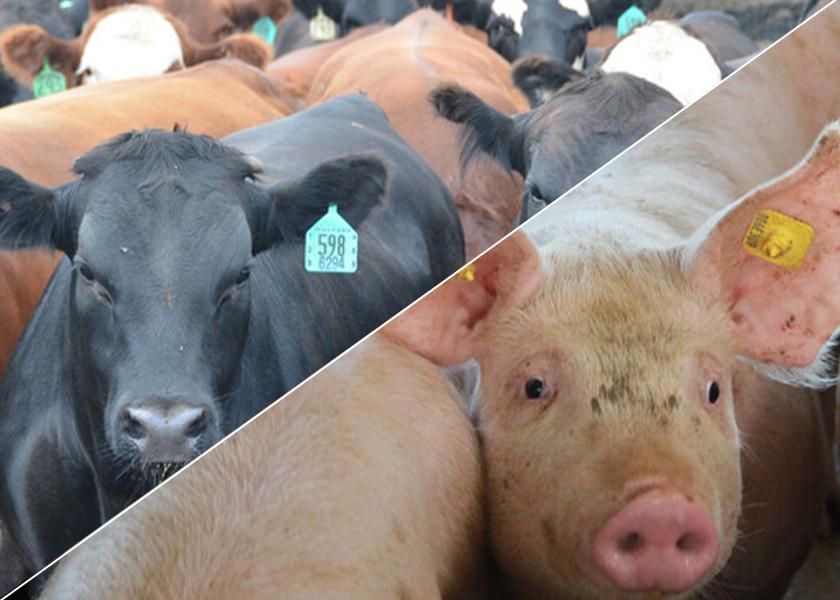Livestock Analysis | February 11, 2022

Price action: April lean hog futures fell $1.20 to $102.225 but gained $2.30 for the week.
5-day outlook: Yesterday’s technically bearish “key reversal” lower in lean hogs was confirmed by followthrough selling pressure today. The market had rallied sharply, having posted contract highs three out of five days this week, and was due for a corrective pullback. Price action early next week will be important, as further selling would suggest a market top is in place, while a strong rebound in prices would indicate potential for more upside. Cash market fundamentals remain supportive for futures. Pork cutout values soared $12.47 early today to $113.95, led by a gain of over $33 in hams. Movement by at midday was strong at 208 loads. The five-day rolling average cash hog prices today was $76.65. February lean hog futures expire Monday and settle against the cash index Wednesday. The February contract holds a premium of about $1.50 to the next projected cash index quote. The preliminary figure for the next CME lean hog index is $88.92, up $1.18.
30-day outlook: The premiums the spring and summer lean hog futures contracts hold to the February contract portend elevated hog prices heading into spring. Seasonal patterns suggest steady-to-lower price action in cash hog prices from mid-February to early April. Recent slaughter figures show hog supplies are falling below the 6% annual reduction indicated by USDA in its last hogs and pigs report, which should also continue to support the hog market in the coming weeks.
90-day outlook: Easter ham demand in the nearer term and the onset of grilling season in the springtime, as well as the tendency for hog supplies to drop to annual lows in early summer, are bullish seasonal elements that should keep a floor under hog prices. High beef prices at the meat counter and the general rally in raw commodity markets amid inflation concerns should also work in favor of hog market bulls in the next few months.
What to do: You are hand-to-mouth on corn-for-feed and soybean meal needs. Wait on an overdue corrective pullback to extend coverage.
Hedgers: Carry all risk in the cash market for now.
Feed needs: You remain hand-to-mouth on soybean meal and corn-for-feed needs.
Price action: April live cattle futures fell 70 cents to $146.175, down 70 cents for the week. March feeder cattle fell 50 cents to $166.225, up 12.5 cents for the week.
5-day outlook: After having bounced strongly last week, the bulk of this week’s cash trading took place at virtually unchanged levels around $140. However, packers began paying up to $142 yesterday, which pushed the four-day average for the five main direct markets up to $140.35, up 47 cents from the week prior. That occurred despite the ongoing slide in wholesale beef prices. Choice cutout slipped another 10 cents to $274.72 at noon today. Still, packer margins remain deep in the black, so with fed cattle supplies at or near usual annual lows, cash cattle prices seem likely to continue rising over the short term. This week’s strong slaughter, which topped the comparable year-ago total by 53,000 head (8.7%), shows packers are playing catch-up and implies they’ll continue actively pursuing cattle in the short run.
30-day outlook: With Lent starting March 2, consumer demand for red meat is unlikely to climb in the short run, which may tend to slow bullish momentum during late February. Nevertheless, the seasonal shortage of fed cattle will probably lend considerable support for cash prices over the next month. Grocers often step up their wholesale buying during the first half of most months as they gear up for beef features over the first weekend of the month following, since that’s when consumers generally have more cash on hand, so stronger beef buying could also boost cattle prices through early March.
90-day outlook: Fed cattle supplies regularly start increasing from annual lows in February-March toward summer highs, but the resulting downward pressure upon cattle prices is often offset through April as grilling season demand shows up at the wholesale, then retail levels. However, the upside potential for spring-summer cattle and wholesale beef prices may be limited by greatly elevated retail beef prices.
The phenomenon was best demonstrated by the events of 2014-16. Cattle and beef markets were boosted by the huge pork shortage (as well as the cyclical low in the low in the cattle population) in 2014. Cattle prices peaked in October 2014, but retail beef prices didn’t peak until July 2015. The subsequent bear market in cattle prices didn’t bottom until October 2016. We don’t expect a sustained bears market in cattle, since, as USDA’s January Cattle Inventory report indicated, the cattle cycle is still very much in its liquidation phase, but we still expect high retail prices to stifle consumer demand and limit the market’s upside potential in the months ahead.
What to do: You are hand-to-mouth on corn-for-feed and soybean meal needs. Wait on an overdue corrective pullback to extend coverage.
Hedgers: Carry all risk in the cash market for now.
Feed needs: You remain hand-to-mouth on soybean meal and corn-for-feed needs.






